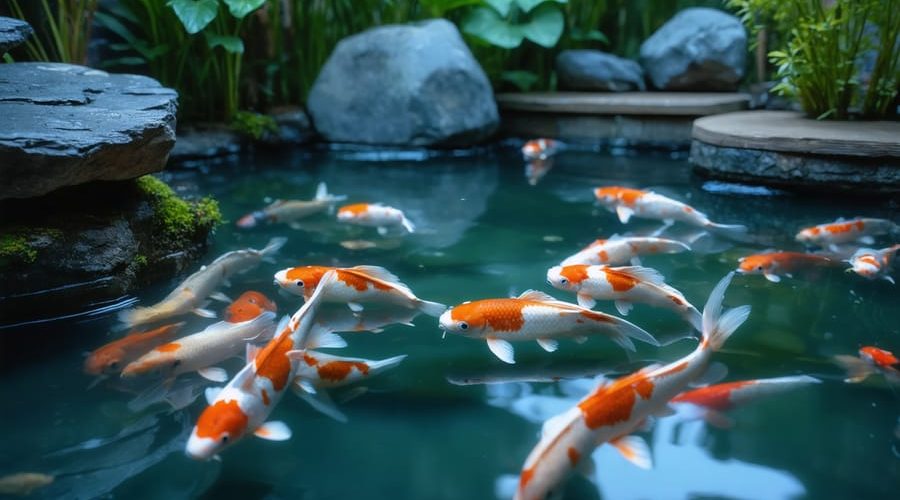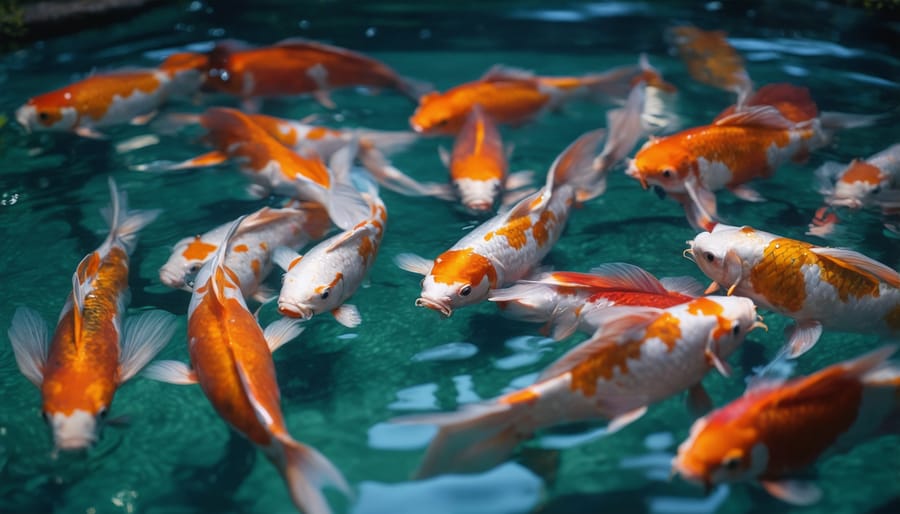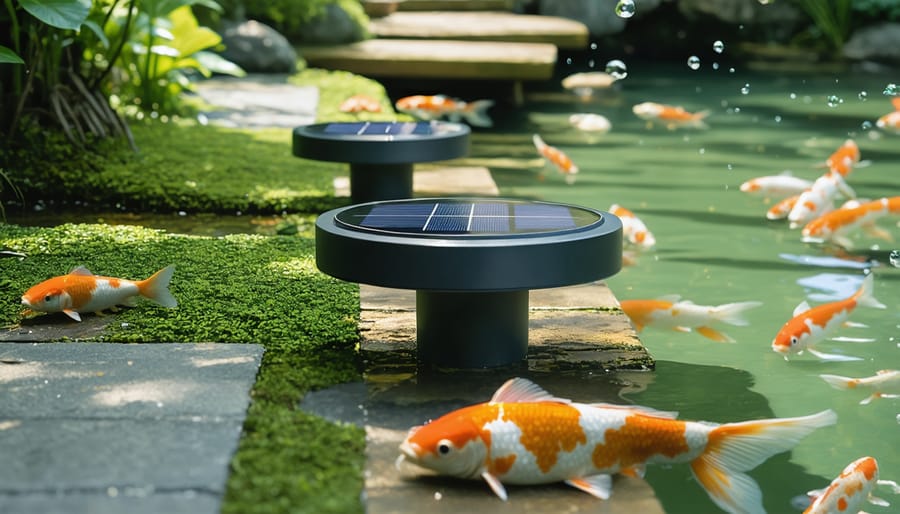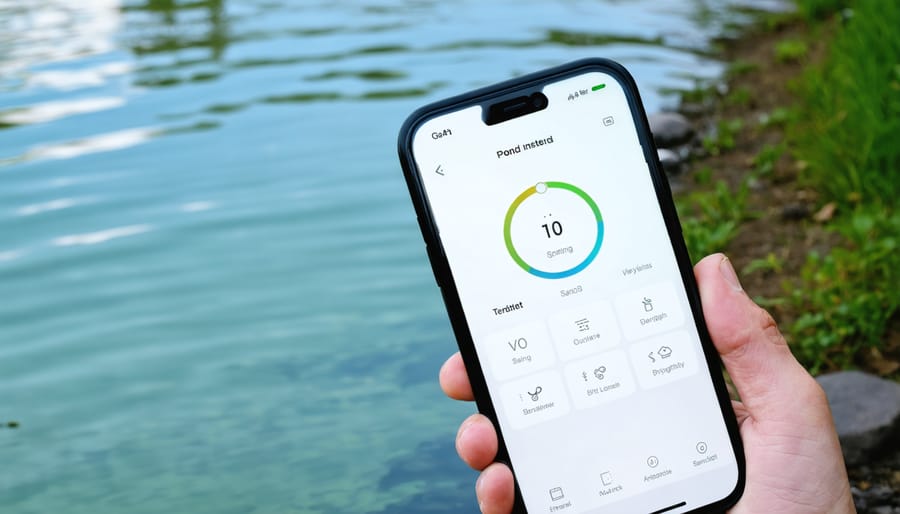
Beautiful Koi Pond Lighting That Won’t Harm Your Fish (Or the Planet)
Transform your koi pond into a mesmerizing nighttime oasis while protecting your precious fish with strategic lighting choices. The right illumination not only creates stunning reflections on the water’s surface but also enhances the natural beauty of your koi’s vibrant colors and graceful movements after sunset.
Modern LED pond lighting offers the perfect balance between aesthetic appeal and ecological responsibility. These energy-efficient options consume up to 80% less electricity than traditional halogen lights while providing exceptional brightness and customizable color options. More importantly, they generate minimal heat, ensuring your koi remain comfortable in their carefully maintained environment.
When designing your pond lighting system, consider three key elements: underwater lights to showcase your fish, perimeter lighting to highlight landscaping features, and safety lighting for walkways. The combination of these lighting types creates depth, dimension, and drama while maintaining the peaceful atmosphere that makes koi ponds so captivating.
With proper placement and timing controls, your pond lighting can serve multiple purposes – from creating an enchanting evening entertainment space to providing essential visibility for feeding and monitoring your koi after dark. By following eco-friendly lighting principles, you’ll create a sustainable nighttime display that enhances both your outdoor living space and your koi’s natural habitat.
Why Eco-Friendly Lighting Matters for Your Koi
The Effects of Artificial Light on Koi Behavior
Artificial lighting can significantly impact your koi’s well-being, making it crucial to understand its effects when creating a koi-friendly environment. Like most fish, koi rely on natural light cycles to regulate their feeding, breeding, and sleeping patterns. Too much artificial light, especially during nighttime hours, can disrupt these natural rhythms and cause stress.
Bright, harsh lighting can make koi feel exposed to predators, leading to anxiety and reduced activity. They may hide more frequently or show signs of distress through erratic swimming patterns. On the flip side, soft, ambient lighting that mimics moonlight can actually help koi feel secure while allowing them to navigate their environment safely at night.
Color temperature also plays a role in koi behavior. Warm white lights (2700-3000K) tend to be less stressful for koi compared to cool white or bluish lights. It’s best to use lighting that gradually dims at sunset and brightens at sunrise, mimicking natural light patterns. This gentle transition helps maintain your koi’s natural biological clock and reduces stress levels.

Environmental Impact of Traditional Pond Lighting
Traditional pond lighting systems, while beautiful, can have a significant environmental impact that many pond owners might not realize. Conventional halogen and incandescent lights consume substantial amounts of electricity, often requiring 50-150 watts per fixture. For a typical koi pond setup with 4-6 lights running for 6-8 hours each night, this can add hundreds of dollars to your annual energy bills while contributing to unnecessary carbon emissions.
These older lighting systems also generate considerable heat, which can affect the delicate ecosystem of your pond. The excess heat can potentially alter water temperature near the lights, affecting both plant growth and your koi’s comfort. Additionally, traditional bulbs have a relatively short lifespan of around 2,000 hours, meaning more frequent replacements and increased waste in landfills.
The manufacturing and disposal of traditional bulbs also raise environmental concerns. Many contain materials that can be harmful to the environment if not properly disposed of, and their frequent replacement cycle means more resources are consumed in production and transportation. This creates a larger ecological footprint than necessary for pond illumination, especially when more sustainable alternatives are readily available.
Solar-Powered Solutions for Your Koi Pond
Types of Solar Lights for Ponds
When it comes to illuminating your koi pond sustainably, modern solar lighting solutions offer several exciting options. Floating solar lights are perhaps the most popular choice, featuring lily pad-shaped designs that create enchanting patterns on the water’s surface. These lights drift gracefully around your pond, requiring no complex installation.
Submersible solar spotlights are another fantastic option, perfect for highlighting specific features or creating dramatic underwater effects. These lights can be secured at the pond’s bottom or along the sides, illuminating your koi as they swim by. Many models come with color-changing capabilities, allowing you to create different moods throughout your garden.
Solar-powered string lights are ideal for decorating around the pond’s perimeter. These versatile lights can be wrapped around plants, rocks, or pergolas, creating a magical atmosphere during evening hours. For a more structured approach, solar bollard lights or path lights installed along the pond’s edge provide both decoration and practical illumination for safety.
Solar-powered fountain lights are perfect if you have a water feature in your pond. These lights often come with built-in sensors that automatically activate at dusk, ensuring your fountain remains a focal point even after sunset. Best of all, these eco-friendly options require no electrical wiring and are completely safe for your koi.

Installation and Placement Tips
Installing pond lighting requires careful planning for the best results. Start by mapping out your pond’s key features and identifying focal points like waterfalls, plants, or favorite spots where your koi gather. Position lights to highlight these areas while avoiding direct glare into viewing areas or your home’s windows.
For underwater lights, place them at varying depths, typically 4-8 inches below the water surface. Angle them slightly upward to create beautiful shimmer effects while ensuring they don’t shine directly into your fish’s eyes. Space multiple lights evenly around the pond’s perimeter for balanced illumination.
Above-water spotlights work best when concealed among rocks or plants. Mount them 2-3 feet above the water surface and angle them downward at about 45 degrees. This positioning minimizes reflection and creates gentle, natural-looking illumination across the water’s surface.
When running electrical cables, always use waterproof conduits and keep connections well above water level. Consider installing lights on different circuits to create various lighting scenes. For easy maintenance, position transformers and junction boxes in accessible locations, protected from the elements but within reach for regular checks.
Remember to test your lighting placement at night before permanent installation. View the pond from different angles and adjust positions until you achieve your desired effect. Start with fewer lights than you think you’ll need – you can always add more later if necessary.
LED Lighting: The Energy-Efficient Choice
Choosing the Right LED Lights
When selecting LED lights for your koi pond, it’s essential to choose fixtures that provide both beauty and functionality while keeping your fish healthy. For those interested in DIY pond lighting solutions, LED lights offer the perfect combination of efficiency and versatility.
Look for waterproof LED lights with an IP68 rating, which ensures complete protection against water damage. Color temperature is crucial – opt for warm white LEDs (2700K-3000K) that create a natural, cozy ambiance without disturbing your koi’s natural behavior. For larger ponds, consider 12-watt to 15-watt fixtures, while smaller ponds may only need 3-watt to 7-watt options.
Choose lights with adjustable brightness settings, allowing you to customize the illumination based on different times of day or special occasions. Stainless steel or high-grade polymer housings offer excellent durability and resistance to corrosion. For enhanced safety, select low-voltage LED systems (12V or 24V) with UL certification.
Consider lights with wider beam angles (120-140 degrees) for better coverage and fewer fixtures needed. Some modern LED lights come with smart features like programmable timers and color-changing capabilities, though simple, reliable options often work best for koi ponds. Remember to check the warranty period – quality LED fixtures should offer at least a 2-year guarantee.
Energy Savings and Longevity
LED lighting systems are a game-changer for koi pond enthusiasts, offering remarkable energy savings and lasting performance. While the initial investment might be higher than traditional halogen or incandescent options, LED lights typically pay for themselves within two years through reduced electricity costs. Most LED pond lights use up to 80% less energy than conventional lighting, which means significantly lower monthly utility bills.
The longevity of LED lights is equally impressive, with quality fixtures lasting 40,000 to 50,000 hours – that’s about 15-20 years of normal evening use! Compare this to traditional bulbs that might need replacement every 6-12 months, and you’ll see why LED is the smart choice for long-term savings. Plus, you’ll spend less time on maintenance and replacement costs.
Beyond the financial benefits, LED lights maintain their brightness better over time. Unlike traditional bulbs that gradually dim and yellow, LED lights retain about 70% of their initial brightness even after years of use. They’re also more durable, standing up to water exposure and temperature fluctuations without failing.
For the eco-conscious pond owner, LED lighting reduces your carbon footprint while providing reliable illumination for your koi. Many modern LED systems even come with smart controls, allowing you to program lighting schedules and adjust brightness levels, further optimizing your energy usage and extending bulb life.
Smart Lighting Controls and Automation
Timer Systems and Motion Sensors
Automating your koi pond lighting not only adds convenience but also helps create the perfect environment for your fish and garden. Timer systems are a game-changer, allowing you to schedule your lights to turn on at dusk and off at dawn, mimicking natural light cycles. Many modern timers even adjust automatically with seasonal changes, ensuring your lighting schedule stays in sync with nature.
Motion sensors bring another level of sophistication to your pond lighting setup. These smart devices can trigger subtle lighting when you approach the pond, perfect for evening viewing without constantly illuminating the area. Some systems even feature dimming capabilities, gradually increasing light intensity to avoid startling your koi.
For the best results, consider combining both technologies. Use timers for your primary lighting schedule, and add motion sensors for pathway lights or accent features. This dual approach conserves energy while maintaining security and creating a welcoming atmosphere. Many systems now come with smartphone apps, letting you control your pond lighting from anywhere, adjust schedules, and even set special lighting scenes for gatherings or holidays.
Remember to position motion sensors strategically, avoiding areas where trees or plants might trigger false activations. Regular maintenance checks will ensure your automation system continues working efficiently throughout the seasons.
Smart Apps and Remote Control
Today’s pond lighting technology has evolved far beyond simple on/off switches. Smart lighting systems for koi ponds offer unprecedented control and convenience through smartphone apps and wireless connectivity. These modern solutions let you adjust brightness, color, and timing with just a few taps on your screen.
Most smart pond lights connect to your home’s WiFi network, allowing you to control them from anywhere. You can create custom lighting schedules that mimic natural daylight patterns, gradually brightening in the morning and dimming at sunset. This natural transition is less stressful for your koi and adds a beautiful ambiance to your garden.
Many apps also include preset lighting scenes for different occasions. Whether you’re hosting an evening garden party or want a peaceful meditation setting, you can instantly transform your pond’s atmosphere. Some systems even integrate with voice assistants like Alexa or Google Home, making it possible to control your pond lighting hands-free.
These smart systems often include helpful features like maintenance reminders and energy consumption tracking, helping you maintain your pond more efficiently while keeping utility costs in check.

Maintenance and Troubleshooting
Regular maintenance of your pond lighting system ensures longevity and optimal performance while keeping your koi healthy and happy. Just as you maintain your water feature, your lighting setup needs consistent care to function effectively.
Start with a monthly cleaning routine for your underwater lights. Gently wipe the lens covers with a soft cloth to remove algae buildup, which can dim the lighting effect. Check cable connections for signs of wear or damage, especially where they enter the water. If you notice any fraying or exposed wires, replace the fixtures immediately to prevent electrical hazards.
For solar-powered systems, keep the solar panels clean and free from debris. During fall, regularly clear away fallen leaves that might shade the panels. Consider adjusting panel angles seasonally to maximize sun exposure.
Common troubleshooting issues include:
– Dimming lights: Usually indicates dying bulbs or dirty fixtures
– Flickering: Check for loose connections or water ingress
– Complete failure: Inspect GFCI outlets and fuses first
– Inconsistent solar performance: Verify panel positioning and cleanliness
LED lights rarely need bulb replacement, but when they do, always choose models rated for underwater use. Keep spare fixtures on hand for quick replacements. During winter maintenance, inspect all components thoroughly and consider reducing lighting hours to conserve energy.
For optimal performance, test your lighting system weekly and address any issues promptly. This proactive approach prevents major problems and ensures your koi pond remains beautifully illuminated year-round.
Lighting your koi pond doesn’t have to come at the expense of the environment or your fish’s well-being. By choosing energy-efficient LED lights, incorporating solar-powered options, and using timers to control usage, you can create a stunning nighttime display while maintaining an eco-friendly approach. Remember that proper placement and moderate brightness levels will keep your koi happy while still achieving that magical ambiance you desire.
Consider starting small with a few strategically placed lights and gradually expanding your lighting design as you observe how your fish respond. Smart lighting choices not only reduce your carbon footprint but can also lead to significant energy savings over time. Whether you opt for underwater spotlights, floating orbs, or subtle path lighting, there’s an eco-conscious solution for every pond design.
As you implement your lighting plan, remember that the goal is to enhance, not overwhelm, your pond’s natural beauty. By following the guidelines we’ve discussed and prioritizing both aesthetics and environmental responsibility, you’ll create a harmonious nighttime environment that you, your koi, and Mother Nature can all enjoy for years to come.
